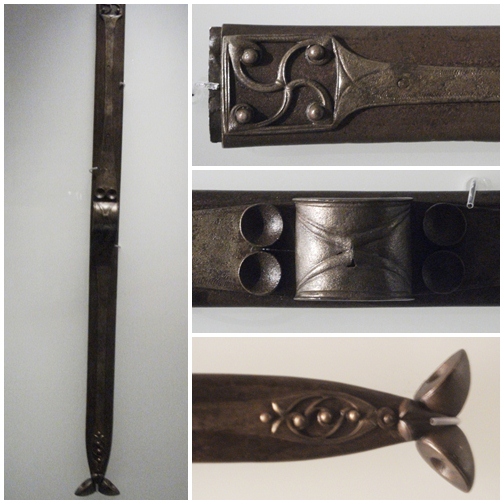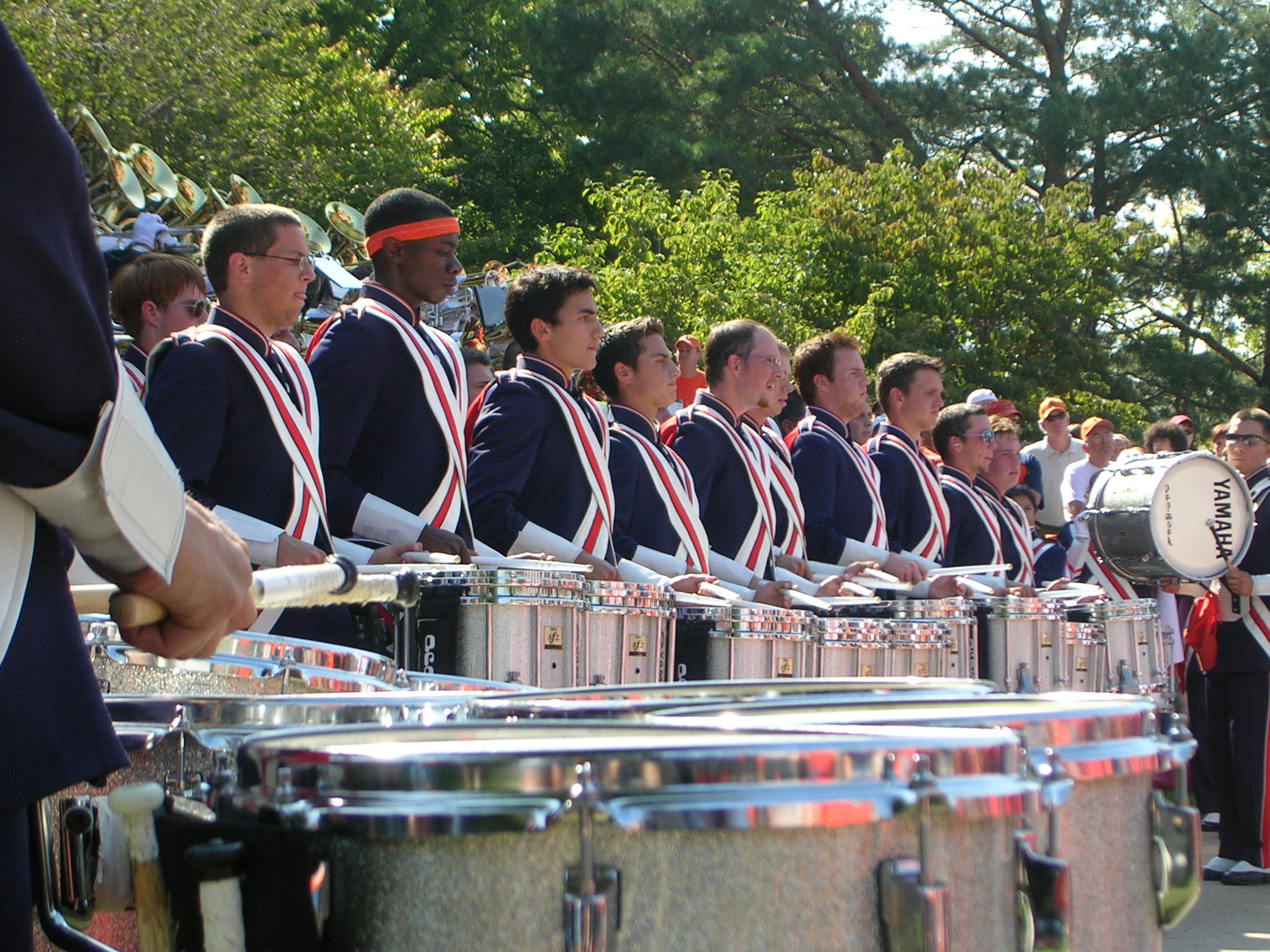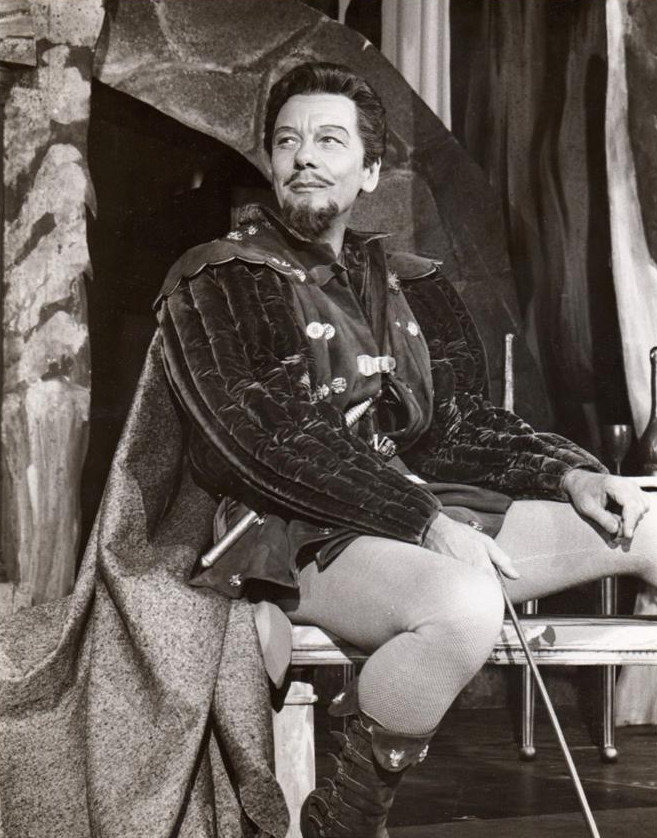|
Baldric
A baldric (also baldrick, bawdrick, bauldrick as well as other rare or obsolete variations) is a belt worn over one shoulder that is typically used to carry a weapon (usually a sword) or other implement such as a bugle or drum. The word may also refer to any belt in general, but this usage is poetic or archaic. In modern contexts, military drum majors usually wear a baldric. Usage Baldrics have been used since ancient times, usually as part of military dress. The design offers more support for weight than a standard waist belt, without restricting movement of the arms, and while allowing easy access to the object carried. Alternatively, and especially in modern times, the baldric may fill a ceremonial role rather than a practical one. Most Roman tombstones in the third century had depictions of white baldrics. Design One end of the baldric was broad and finished in a straight edge, while the other was tapered to a narrow strip. The narrow end was brought through a scabb ... [...More Info...] [...Related Items...] OR: [Wikipedia] [Google] [Baidu] |
Scabbard
A scabbard is a sheath for holding a sword, knife, or other large blade. As well, rifles may be stored in a scabbard by horse riders. Military cavalry and cowboys had scabbards for their saddle ring carbine rifles and Lever action, lever-action rifles on their horses for storage and protection. Scabbards have been made of many materials over the millennia, including leather, wood, and metals such as brass or steel. Most commonly, sword scabbards were worn suspended from a sword belt or shoulder belt called a baldric. Antiquity Wooden scabbards were typically covered in fabric or leather; the leather versions also usually bore metal fittings for added protection and carrying ease. Japanese blades typically have their sharp cutting edge protected by a wooden scabbard called a Japanese sword mountings#Saya, saya. Many scabbards, such as ones the Greeks and Romans used, were small and light. It was designed for holding the sword rather than protecting it. All-metal scabbards were ... [...More Info...] [...Related Items...] OR: [Wikipedia] [Google] [Baidu] |
Pallas (son Of Evander)
In Roman mythology, Pallas (/ˈpæləs/; Ancient Greek: Πάλλας) was the son of King Evander. In Virgil's ''Aeneid'', Evander allows Pallas to fight against the Rutuli with Aeneas, who takes him and treats him like his own son Ascanius. In battle, Pallas proves he is a warrior, killing many Rutulians. Pallas is often compared to the Rutulian Lausus, son of Mezentius, who also dies young in battle. Tragically, however, Pallas is eventually killed by Turnus, who takes his sword-belt, which is decorated with the scene of the fifty slaughtered bridegrooms, as a spoil. Throughout the rest of Book X, Aeneas is filled with rage (''furor'') at the death of the youth, and he rushes through the Latin lines and mercilessly kills his way to Turnus. Turnus, however, is lured away by Juno so that he might be spared, and Aeneas kills Lausus, instead, which he instantly regrets. Pallas' body is carried on his shield back to Evander, who grieves at his loss. However, Pallas' story does not ... [...More Info...] [...Related Items...] OR: [Wikipedia] [Google] [Baidu] |
Morris Dance
Morris dancing is a form of English folk dance. It is based on rhythmic stepping and the execution of choreographed figures by a group of dancers, usually wearing bell pads on their shins. Implements such as sticks, swords and handkerchiefs may also be wielded by the dancers. In a small number of dances for one or two people, steps are near and across a pair of clay tobacco pipes laid one across the other on the floor. They clap their sticks, swords, or handkerchiefs together to match with the dance. The earliest known and surviving English written mention of Morris dance is dated to 1448 and records the payment of seven shillings to Morris dancers by the Goldsmiths' Company in London. Further mentions of Morris dancing occur in the late 15th century, and there are also early records such as bishops' "Visitation Articles" mentioning sword dancing, guising and other dancing activities, as well as mumming plays. While the earliest records invariably mention "Morys" in a court sett ... [...More Info...] [...Related Items...] OR: [Wikipedia] [Google] [Baidu] |
Marching Illini
The Marching Illini (MI) is the marching band of the University of Illinois Urbana-Champaign. The Marching Illini is an organization which annually includes approximately 400 students enrolled in the University of Illinois. Part of the College of Fine and Applied Arts and Illini Athletics, the Marching Illini represent virtually every college, discipline, and major on the university's diverse Urbana-Champaign campus. Performances The Band primarily performs before, during, and after University of Illinois home football games. The band also performs an indoor concert at the Assembly Hall featuring special lighting effects, performances by individual sections, and slightly pithy comic routines. Other performances include a drill for the Illini Marching Festival, halftime performance for the Chicago Bears at Soldier Field, halftime performances at postseason bowl games, and an annual away performance at the home football game of another Big Ten school. The MI does not typically perfor ... [...More Info...] [...Related Items...] OR: [Wikipedia] [Google] [Baidu] |
Alexandre Dumas
Alexandre Dumas (, ; ; born Dumas Davy de la Pailleterie (), 24 July 1802 – 5 December 1870), also known as Alexandre Dumas père (where '' '' is French for 'father', to distinguish him from his son Alexandre Dumas fils), was a French writer. His works have been translated into many languages and he is one of the most widely read French authors. Many of his historical novels of adventure were originally published as serials, including '' The Count of Monte Cristo'', ''The Three Musketeers'', ''Twenty Years After'' and '' The Vicomte of Bragelonne: Ten Years Later''. His novels have been adapted since the early twentieth century into nearly 200 films. Prolific in several genres, Dumas began his career by writing plays, which were successfully produced from the first. He also wrote numerous magazine articles and travel books; his published works totalled 100,000 pages. In the 1840s, Dumas founded the Théâtre Historique in Paris. His father, General Thomas-Alexandre Dumas D ... [...More Info...] [...Related Items...] OR: [Wikipedia] [Google] [Baidu] |
The Faerie Queene
''The Faerie Queene'' is an English epic poem by Edmund Spenser. Books IIII were first published in 1590, then republished in 1596 together with books IVVI. ''The Faerie Queene'' is notable for its form: at over 36,000 lines and over 4,000 stanzas it is one of the longest poems in the English language; it is also the work in which Spenser invented the verse form known as the Spenserian stanza. On a literal level, the poem follows several knights as a means to examine different virtues, and though the text is primarily an allegorical work, it can be read on several levels of allegory, including as praise (or, later, criticism) of Queen Elizabeth I. In Spenser's "Letter of the Authors", he states that the entire epic poem is "cloudily enwrapped in Allegorical devices", and that the aim of publishing ''The Faerie Queene'' was to "fashion a gentleman or noble person in virtuous and gentle discipline". Spenser presented the first three books of ''The Faerie Queene'' to Elizabeth I ... [...More Info...] [...Related Items...] OR: [Wikipedia] [Google] [Baidu] |
Edmund Spenser
Edmund Spenser (; 1552/1553 – 13 January 1599) was an English poet best known for ''The Faerie Queene'', an epic poem and fantastical allegory celebrating the Tudor dynasty and Elizabeth I. He is recognized as one of the premier craftsmen of nascent Modern English verse and is often considered one of the greatest poets in the English language. Life Edmund Spenser was born in East Smithfield, London, around the year 1552; however, there is still some ambiguity as to the exact date of his birth. His parenthood is obscure, but he was probably the son of John Spenser, a journeyman clothmaker. As a young boy, he was educated in London at the Merchant Taylors' School and matriculated as a sizar at Pembroke College, Cambridge. While at Cambridge he became a friend of Gabriel Harvey and later consulted him, despite their differing views on poetry. In 1578, he became for a short time secretary to John Young, Bishop of Rochester. In 1579, he published ''The Shepheardes Calender'' and ... [...More Info...] [...Related Items...] OR: [Wikipedia] [Google] [Baidu] |
Much Ado About Nothing
''Much Ado About Nothing'' is a comedy by William Shakespeare thought to have been written in 1598 and 1599.See textual notes to ''Much Ado About Nothing'' in ''The Norton Shakespeare'' ( W. W. Norton & Company, 1997 ) p. 1387 The play was included in the ''First Folio'', published in 1623. The play is set in Messina and revolves around two romantic pairings that emerge when a group of soldiers arrive in the town. The first, between Claudio and Hero, is nearly altered by the accusations of the villain, Don John. The second romance, between Claudio's friend Benedick and Hero's cousin Beatrice, takes centre stage as the play goes on, with both characters' wit and banter providing much of the humour. Through "noting" (sounding like "nothing", and meaning gossip, rumour, overhearing), Benedick and Beatrice are tricked into confessing their love for each other, and Claudio is tricked into believing that Hero is not a maiden (virgin). The title's play on words references t ... [...More Info...] [...Related Items...] OR: [Wikipedia] [Google] [Baidu] |
William Shakespeare
William Shakespeare ( 26 April 1564 – 23 April 1616) was an English playwright, poet and actor. He is widely regarded as the greatest writer in the English language and the world's pre-eminent dramatist. He is often called England's national poet and the " Bard of Avon" (or simply "the Bard"). His extant works, including collaborations, consist of some 39 plays, 154 sonnets, three long narrative poems, and a few other verses, some of uncertain authorship. His plays have been translated into every major living language and are performed more often than those of any other playwright. He remains arguably the most influential writer in the English language, and his works continue to be studied and reinterpreted. Shakespeare was born and raised in Stratford-upon-Avon, Warwickshire. At the age of 18, he married Anne Hathaway, with whom he had three children: Susanna, and twins Hamnet and Judith. Sometime between 1585 and 1592, he began a successful career in London as an ... [...More Info...] [...Related Items...] OR: [Wikipedia] [Google] [Baidu] |
Canterbury Tales
''The Canterbury Tales'' ( enm, Tales of Caunterbury) is a collection of twenty-four stories that runs to over 17,000 lines written in Middle English by Geoffrey Chaucer between 1387 and 1400. It is widely regarded as Chaucer's ''magnum opus''. The tales (mostly written in verse, although some are in prose) are presented as part of a story-telling contest by a group of pilgrims as they travel together from London to Canterbury to visit the shrine of Saint Thomas Becket at Canterbury Cathedral. The prize for this contest is a free meal at the Tabard Inn at Southwark on their return. It has been suggested that the greatest contribution of ''The Canterbury Tales'' to English literature was the popularisation of the English vernacular in mainstream literature, as opposed to French, Italian or Latin. English had, however, been used as a literary language centuries before Chaucer's time, and several of Chaucer's contemporaries—John Gower, William Langland, the Pearl Poet, and J ... [...More Info...] [...Related Items...] OR: [Wikipedia] [Google] [Baidu] |
Chaucer
Geoffrey Chaucer (; – 25 October 1400) was an English poet, author, and civil servant best known for '' The Canterbury Tales''. He has been called the "father of English literature", or, alternatively, the "father of English poetry". He was the first writer to be buried in what has since come to be called Poets' Corner, in Westminster Abbey. Chaucer also gained fame as a philosopher and astronomer, composing the scientific ''A Treatise on the Astrolabe'' for his 10-year-old son Lewis. He maintained a career in the civil service as a bureaucrat, courtier, diplomat, and member of parliament. Among Chaucer's many other works are ''The Book of the Duchess'', ''The House of Fame'', ''The Legend of Good Women'', and ''Troilus and Criseyde''. He is seen as crucial in legitimising the literary use of Middle English when the dominant literary languages in England were still Anglo-Norman French and Latin. Chaucer's contemporary Thomas Hoccleve hailed him as "the firste fyndere of ou ... [...More Info...] [...Related Items...] OR: [Wikipedia] [Google] [Baidu] |

.jpg)


.jpg)



